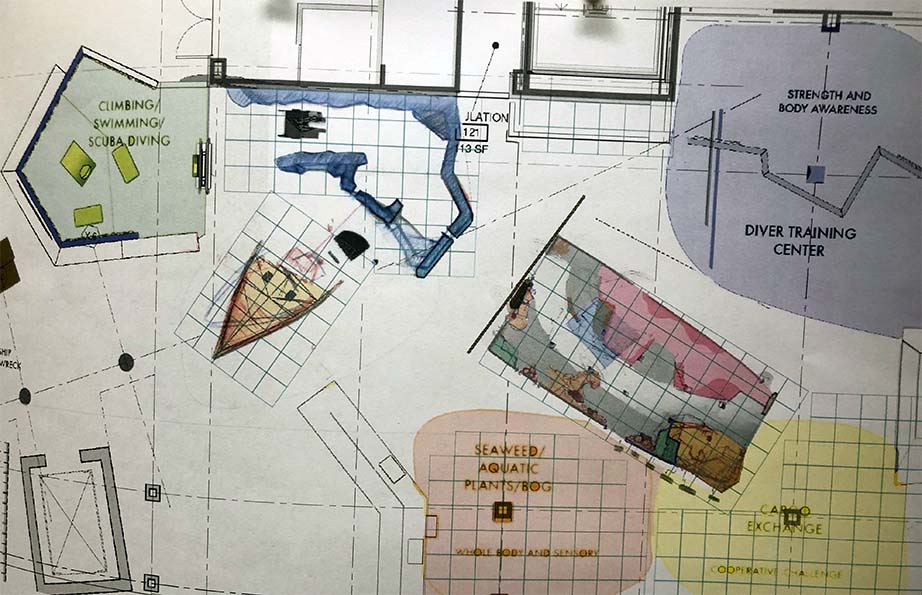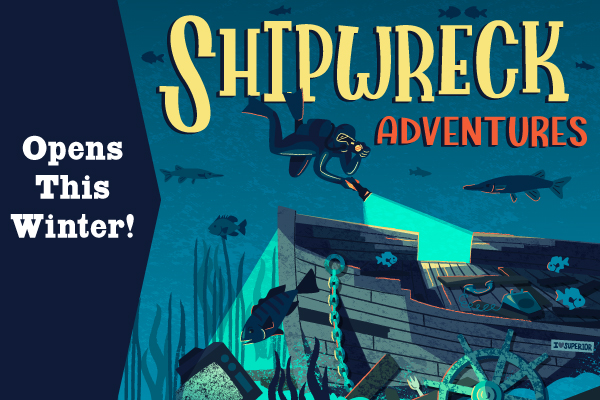The Making of Shipwreck Adventures Home

From Concept to Design: An Interview with Senior Exhibit Designer Christopher Lee
The concept for Shipwreck Adventures had taken shape: An interactive exhibit based on a real-life shipwreck in Lake Superior. The exhibit developer had conducted research, visited the North Shore for inspiration and met with one of the divers that had discovered the wreck. Now it was senior exhibit designer Chris Lee’s time to shine. His task: Turn great ideas and lots of research into actual building plans.
We spoke with Chris to learn more about the role of an exhibit designer and hear about his process for creating new exhibits like Shipwreck Adventures.
For those not familiar, can you explain what you do as an exhibit designer?
In a nutshell, I take exhibit ideas and figure out how to make them real so visitors can play with them. I work through the steps involved to take a vision or thought and turn it into something physical. While the exhibit developer (in the case of Shipwreck Adventures, Mary Weiland) focuses on the ideas and content of the experience, I focus on how we make that happen through things like materials, atmosphere, mood and visual narrative.
Then, I get into the nuts and bolts: Do we have enough room for what we want to do? Is it safe for visitors? How long should this video last to best engage kids? And as we move on in the process, we get even deeper and more specific: What paint colors should we use? Should that piece be an inch bigger or an inch smaller? How should that drawer open? How do we add a surprise to this area?
Finally, I work closely with the exhibit fabricators to figure out how best to build things, what the cost will be, etc. It’s not that you just create a blueprint and walk away when it goes to fabrication. It’s a continual collaboration.
When do you come into the process of designing a new exhibit?
I usually step in near the beginning of the process, often during brainstorming sessions. Creating an exhibit is a gradual process of slowing bringing something into focus. We go through multiple versions of ideas, check in with each other, share feedback and adjust. It’s hard to say where design and development start and stop.
With Shipwreck Adventures, after Mary laid the initial groundwork, we worked together to figure out the schematic design and get a rough idea of what things might look like. Then we figure out whether or not our vision is even possible. Sometimes things sound great in theory, but then don’t work in real life. It’s like sharpening a pencil as you go.
An example of a floor plan layout of Shipwreck Adventures. Floor plans are one of the many tools exhibit designers use in their creation process.
What are some of your favorite tools you use as you’re designing?
Creative ideas and an open mind have to be my most favorite tools. Other useful tools are pencil and paper so I can sketch and get something out of my head in a way that someone else can see and react to it. I might use cardboard and tape and literally put structures together. Or I might use CAD software to create empty shells of exhibit spaces and walk into the space virtually. And I use fly-throughs and functional 3D models to test ideas and layouts.
What is your favorite part of Shipwreck Adventures?
I love the fact that it’s a narrative-based exhibit. It’s great to be able to invite people into a story and transport them to another place or time – in this case, the bottom of the lake.
This exhibit is so different from anything else at the museum. It lets kids flex their imagination muscles in a whole different way. We drop you into the story, and let you explore it on your own terms. We’ve got so many fun experiences in the museum, but nothing quite like this.



